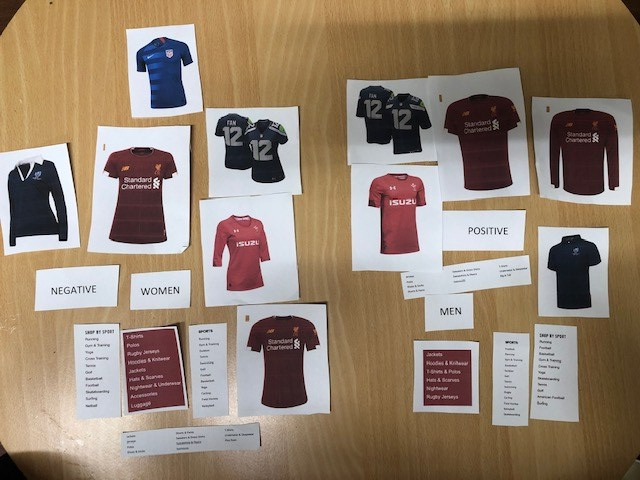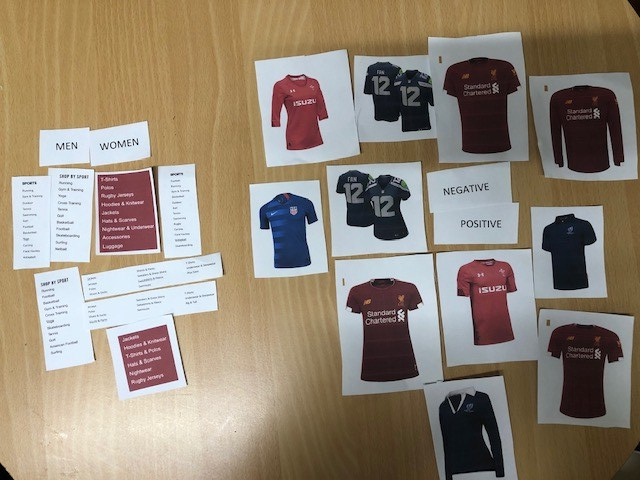How obvious are gender labels on sports merchandise websites?
- Gabriella H Axelson
- Sep 29, 2019
- 3 min read
Updated: Oct 5, 2021
For one of my classes for my master's degree, I had to create a portfolio where I applied some of the research methods I had learned to answer a question. While it is often understood that male athletes tend to get more representation than female athletes, I wanted to see how this bias affects sports merchandise, and how a group of students would perceive this. In order to do so, I used the method of group card-sorting. By implementing this research strategy, I could see what choices each individual made, and how it was influenced by factors such as personal experiences, opinions, and from the others who were participating in the card sorting as well.
For this research method, I had six people sort 23 cards into two categories as a team—these 23 cards can be seen in Appendix A. By having everyone discuss their logic for the sorting, I could observe not only their thought process behind each sort, but also observe the interaction between members in regards to gender stereotypes they have observed.
Beforehand, I spent a day researching what articles of clothing I could use to be sorted. I ended up deciding to focus only on sports team clothing/jerseys, as one does not have to participate in the sport in order to appreciate or be a fan of the specific team. I also chose these ‘sports team gear’ because they offered the clearest and most concise way to compare representation, since the teams would have a ‘women’s jersey and the ‘men’s jersey of the same style. I also decided to include the ‘women’s and ‘men’s merchandise list, as I was curious to see if gender stereotyping would be interpreted through the lists as well—for the purpose of this project, I cut out any terms that were gender specific, such as dresses or skirts. I included the words women, men, negative and positive to see how they would be categorized with the jerseys and lists.
To execute this research method, I spent a total of 30 minutes (15 minutes to sort the cards, 15 minutes to discuss outcome) with the group. I instructed them to sort the cards into two piles, in whichever way they want. The only rules I set were that each card had to be used, and they had to explain each decision.
Participants immediately began discussing ways to group each card. First thoughts were to group based off of gender, followed by colour and sports. For the sports merchandise, it was immediately recognizable which shirts were men’s and women’s. After recognising some of the differences between the shirts, some of the participants began analysing the cards that had lists on them to see what the differences were. After about 15 minutes, the group decided they had sorted everything into the category they wanted. What I found most interesting in their sort method was that they ensured each pile was balanced, and grouped ‘negative’ with ‘women’ (Appendix B). When I asked them the reasoning behind this, they explained that women’s apparel fit an ‘ideal’ body type, whereas men’s apparel gave a wide variety of options that fit any body type.
After the results of the group card sorting, I grew curious to see if I would have gotten different results had I have had everyone sort the cards individually. So I decided to repeat the process with two more people, individually this time. I found that when sorting the cards by one self, the participant was more likely to sort based off of visual cues. For example, two participants decided to group all of the jersey cards together, and all of the written cards together. One explained their reasoning behind this as being it was the process they took when ordering a new jersey—they pay attention to colour, fit, fabric being used—and group ‘negative’ and ‘positive’ with the jersey’s as the participant would consider whether each item had a ‘good’ or ‘positive’ fit, colour for skin tone, fabric (appendix C). The other participant purposefully put ‘women’ next to ‘positive,’ and although in the same category, explained the reasoning as women need to be ‘empowered’ and ‘lifted-up’ since sports is a males dominate sports (appendix D). Furthermore, this participant explained that they wanted to ignore what they perceived as gender labels, and instead grouped based off of visual versus text/written.
Appendix A
Appendix B

Appendix C

Appendix D





Comments